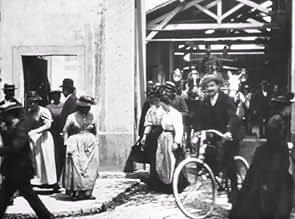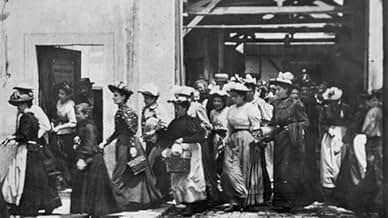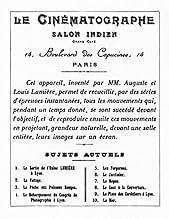Arbeiter verlassen die Lumière-Werke
Originaltitel: La sortie de l'usine Lumière à Lyon
IMDb-BEWERTUNG
6,8/10
8040
IHRE BEWERTUNG
Füge eine Handlung in deiner Sprache hinzuWorkers leaving the Lumière factory for lunch in Lyon, France in 1895; a place of great photographic innovation and one of the birth places of cinema.Workers leaving the Lumière factory for lunch in Lyon, France in 1895; a place of great photographic innovation and one of the birth places of cinema.Workers leaving the Lumière factory for lunch in Lyon, France in 1895; a place of great photographic innovation and one of the birth places of cinema.
- Regie
Empfohlene Bewertungen
This one-minute film is arguably the first movie ever made. Other inventors had previously filmed actions - like Edison's motion photography of a sneeze - but the Lumiere brothers developed equipment that tremendously advanced the medium. At the time, of course, their `cinematograph' must have bewildered their peers, including their subjects. In this first instance, the brothers record employees leaving their factory, some of whom understandably struggle to hide their awareness of the camera. The Lumieres attempt to make the film more entertaining by introducing animals and a bicycle, but `La Sortie Des Usines Lumiere' doesn't nearly match the ingenuity of their later films. The most interesting aspect of this short film is the brothers' selection of a familiar working class ritual as their subject. Their choice is the initial evidence of their curiosity about all of the world's people, a quality that makes viewing their experiments immensely rewarding and fascinating today.
Rating: 8
Rating: 8
Even as the first film to come to cinema, it's still better than a lot of the films that come out today. The origin story of this film is completely fascinating. An unknowing audience attend the cinema assuming it will be a series of still images, until they get hit with the greatest twist of all time - a moving picture. The 33/100 who went to see this film are some of the luckiest people of all time, just imagine their shock.......
On the 28th of December, 1895, in the Grand Café in Paris, film history was writing itself while Louis Lumière showed his short films, all single shots, to a paying audience. 'La Sortie des Usines Lumière' was the first film to be played and I wish I was there, not only to see the film, but also the reactions of the audience.
We start with closed doors of the Lumière factory. Apparently, since the image seems a photograph, people thought they were just going to see a slide show, not something they were hoping for. But then the doors open and people are streaming out, heading home. First a lot of women, then some men, and one man on a bike with a big dog. When they are all out the doors close again.
Whether this is the first film or not (some say 'L'Arrivée d'un Train à la Ciotat' was the first film Lumière recorded), it is an impressive piece of early cinema. Being bored by this is close to impossible for multiple reasons. One simple reason: it is only fifty seconds long. But also for people who normally only like the special effect films there must be something interesting here; you don't get to see historical things like this every day.
We start with closed doors of the Lumière factory. Apparently, since the image seems a photograph, people thought they were just going to see a slide show, not something they were hoping for. But then the doors open and people are streaming out, heading home. First a lot of women, then some men, and one man on a bike with a big dog. When they are all out the doors close again.
Whether this is the first film or not (some say 'L'Arrivée d'un Train à la Ciotat' was the first film Lumière recorded), it is an impressive piece of early cinema. Being bored by this is close to impossible for multiple reasons. One simple reason: it is only fifty seconds long. But also for people who normally only like the special effect films there must be something interesting here; you don't get to see historical things like this every day.
For almost anyone with an interest in the earliest motion pictures, watching this footage of workers leaving the Lumière factory never gets old. Its historical significance, as the first movie that Louis Lumière showed at the first public demonstration of his cinematograph, would certainly make it well worth remembering for that reason alone. But beyond Lumière's visionary and technical abilities, he also had a knack for choosing material for his features that was interesting in itself.
This particular subject could not have been more appropriate for his first public presentation. The seemingly simple footage is almost a microcosm of the new world created by cinema. The widely varying reactions of the various workers (not to mention the occasional dog) contain almost every common reaction to the camera: some are curious and don't mind showing it, some are curious and pretend not to be, some are a little uncomfortable, some seem to be fascinated by having their picture taken. With the 'cast' as large as it is, you can watch the film a good number of times and still not lose interest.
Beyond that, the way that the camera field is set up shows an innate sense of the value of movement, particularly movement towards the camera, in holding the attention of the audience. Some of Lumière's best films made further use of this idea.
In one very short movie, this film preserves an important step in cinema history, while also containing material that, in a sense, portrays and foresees many of the future effects of the Lumière brothers' invention. That we can experience both, any time that we view this footage of these long-past men and women and their honest reactions to the camera, is still fascinating.
This particular subject could not have been more appropriate for his first public presentation. The seemingly simple footage is almost a microcosm of the new world created by cinema. The widely varying reactions of the various workers (not to mention the occasional dog) contain almost every common reaction to the camera: some are curious and don't mind showing it, some are curious and pretend not to be, some are a little uncomfortable, some seem to be fascinated by having their picture taken. With the 'cast' as large as it is, you can watch the film a good number of times and still not lose interest.
Beyond that, the way that the camera field is set up shows an innate sense of the value of movement, particularly movement towards the camera, in holding the attention of the audience. Some of Lumière's best films made further use of this idea.
In one very short movie, this film preserves an important step in cinema history, while also containing material that, in a sense, portrays and foresees many of the future effects of the Lumière brothers' invention. That we can experience both, any time that we view this footage of these long-past men and women and their honest reactions to the camera, is still fascinating.
The appeal of ancient films like this one is that you get to see an actual moving image of life over 100 years ago. Here are a lot of people leaving a factory, all of them dead by now and none of them even remotely aware of the magnitude of the invention that they are walking before. I was shocked to read one reviewer call this film as boring as home videos today, and at least one other mistakenly identified it as the first film ever made (it was the first film made at the rate of 16 frames per second, rather than the then-normal 46 frames per second).
Sure, all you see is a lot of people filing out of a building and passing before the cinematograph on their way home from work, but this is a curiosity piece for dozens of reasons, not the least of which is that it was the first film made by the Lumiére brothers, who probably had a stronger impact on the development of the cinema than any other individual or group of individuals in history.
Sure, all you see is a lot of people filing out of a building and passing before the cinematograph on their way home from work, but this is a curiosity piece for dozens of reasons, not the least of which is that it was the first film made by the Lumiére brothers, who probably had a stronger impact on the development of the cinema than any other individual or group of individuals in history.
Wusstest du schon
- WissenswertesIt was the first film ever to be projected to a paying audience.
- Alternative VersionenThree versions of the film exist. There are a number of differences between them, such as the clothing styles worn by the workers change to reflect the different seasons the versions were shot in, and the horse-drawn carriage that appears in the first version is pulled by one horse, two horses in the second version, and no horse and no carriage in the third version.
- VerbindungenEdited into The Lumière Brothers' First Films (1996)
Top-Auswahl
Melde dich zum Bewerten an und greife auf die Watchlist für personalisierte Empfehlungen zu.
Details
- Erscheinungsdatum
- Herkunftsland
- Offizielle Standorte
- Sprache
- Auch bekannt als
- Arbeiter beim Verlassen einer Fabrik
- Drehorte
- Produktionsfirma
- Weitere beteiligte Unternehmen bei IMDbPro anzeigen
- Laufzeit
- 1 Min.
- Farbe
- Sound-Mix
- Seitenverhältnis
- 1.33 : 1
Zu dieser Seite beitragen
Bearbeitung vorschlagen oder fehlenden Inhalt hinzufügen




















